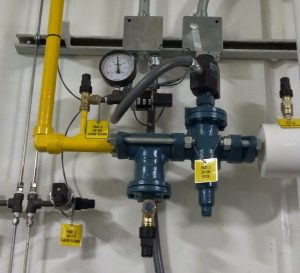Emergency Pressure Control Systems
This is an update to a blog that was originally posted on 9/10/14. You can read the original blog here.
Question: What is an emergency pressure control system?
Answer: An emergency pressure control system (EPCS) is a pressure-limiting safety system that is required by many current Fire Codes (International Fire Code and NFPA 1). The EPCS has replaced the Emergency Control Box (sometimes called Dump Box, Red Box, Fire Department Box, etc.) as a code-required safety system for over-pressurization events. The EPCS differs from the Emergency Control Box in many ways. The two (2) most significant differences are:
- An EPCS is activated automatically, whereas an ECB can only be activated manually.
- An ECB includes a provision for manually discharging the refrigeration system. An EPCS has no such provision.
Essentially, the EPCS is an overpressure protection device that activates in an over-pressure situation above the pressure limiting device set pressure, but below the relief valve set pressure to allow the portion of the system subject to over-pressure to be relieved of its pressure by moving refrigerant through a solenoid valve to a lower pressure portion of the system. ANSI/IIAR 2-2021 Appendix I provides the most thorough description of proper EPCS installation and operation. The following is a summary of proper EPCS functionality:
- An EPCS should be arranged to activate at a pressure not greater than 90% of the pressure relief device setting or 95% of the pressure relief device setting when a rupture disc is installed upstream of the relief device. [ANSI/IIAR 2-2021 Appendix I.4.5.3]
- Upon activation, all compressors should be stopped by a means that is independent of the high pressure safety control [ANSI/IIAR 2-2021 Appendix I.4.5.6]
- Upon activation, the cross-over valve(s) should be opened [ANSI/IIAR 2-2021 Appendix I.4.5.6]
- After activation, condenser fans and pumps should be stopped if the system pressure falls below 90 psig. [ANSI/IIAR 2-2021 Appendix I.4.5.6]
- Upon activation, a signal should be provided to personnel responsible for refrigeration system maintenance [ANSI/IIAR 2-2021 Appendix I.4.5.7]
- EPCS should remain active until manually reset [ANSI/IIAR 2-2021 Appendix I.4.5.8]
- EPCS crossover isolation valves should be locked open [ANSI/IIAR 2-2021 Appendix I.4.4.2]
In addition, a written procedure for the operation and testing of the EPCS should be developed [ANSI/IIAR 2-2021 Appendix I.4.7] so that the EPCS can be tested as part of the annual system safety tests [ANSI/IIAR 2-2021 Appendix I.4.6].



Leave a Reply